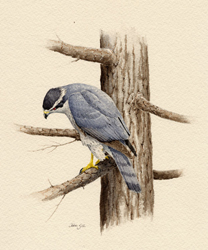Breeding Bird Atlases (BBA)
Find a Bird - BBA1
Breeding Bird Atlas 1 Species Accounts
Northern Goshawk
Accipiter gentilis
Egg Dates
March 30 to June 28
Number of Broods
one; may re-lay if first attempt fails.

The Northern Goshawk, one of the most powerful and agile raptors of the Holarctic region, is an uncommon resident of the Alaskan and Canadian boreal and mixed forests and their southward extensions into the United States. It breeds sparsely throughout much of Massachusetts, southeastward to include Plymouth County. The handsome proportions of this bird, as well as its courage and cunning in pursuing prey, have made it a favorite of the world’s falconers.
Goshawks usually seek dense forest to breed, preferring remote, secluded stands of mixed conifers and hardwoods. Prior to the 1950s, it was rare to find one nesting in Massachusetts, but, subsequently, Massachusetts forests once again reached sufficient maturity to support breeding pairs. However, in recent years goshawks have been discovered nesting in smaller woodlots and in areas subject to a great deal of human disturbance, especially in eastern and central Massachusetts.
Pairs arrive on their breeding territories by late March. Sometimes a new nest is built, usually in the same woodland occupied previously, or an old nest is refurbished. Rarely is the nest of another species utilized. The structure, located 20 to 70 feet up in a conifer or hardwood, is large (up to 5 feet across) and well constructed of sticks, mostly pine and Eastern Hemlock, broken from living trees. Many of these branches have green needles, and later fresh sprigs may be added. In Massachusetts, White Pine is a preferred nest tree species, along with Eastern Hemlock and Red Oak. A forest pond, stream, or lake often is located nearby because goshawks love water and may spend up to an hour bathing and preening.
The spectacular flight display occurs before and during nest repair or construction, beginning either with the male diving at the female from soaring flight or by a high-speed chase below treetop level. Eventually, the birds fly slower, with deep wing beats and long glides, and gradually get closer together. During the display, both birds are highly vocal. The mating period is prolonged, and the female often initiates copulation by crouching low on a branch with drooped wings while flagging her white undertail coverts.
Goshawks are usually silent except during the reproductive period, when they produce a variety of sounds. Both males and females give the alarm or battle cry, a strident, rapidly repeated kak-kak-kak-kak or kuk-kuk-kuk-kuk, deeper and hoarser in the female. Pairs converse during courtship flight in high-pitched querulous kee-a-ahs. After leaving the nest, the young use a version of this call, a single kree-ah. Other calls signify recognition, dismissal, and apprehension.
The Northern Goshawk is the boldest and most reckless of all raptors when defending its nest. Even the vicinity, as far as a half-mile away from the nest, can be dangerous. No intruder is spared; not human, dog, horse, wolf, or bear. When attacking, the goshawk aims for the highest point: humans are struck on the head and animals on the rump.
A clutch of one to five (usually three or four) eggs, depending on the abundance of food, is incubated by the female for 35 to 40 days, during which time she is fed by the male. The downy young develop quickly, and feathering is complete at five to six weeks. At 12 Massachusetts nests, brood sizes were as follows: one nestling (3 nests), two nestlings (5 nests), three nestlings (2 nests), and four nestlings (2 nests) (Olmstead). Most records of nestlings were from May to July.
The male usually has a plucking log where he decapitates and prepares prey before carrying it to the nest. The female tears the food into pieces and offers it to the insatiable young. In times of severe food shortage, the larger siblings may attack, kill, and eat the weaker ones. Young leave the nest and perch on branches at 40 days and fly at 45 days of age. Approximate fledging dates at 5 Massachusetts nests were June 10, June 14, July 4, July 14, and July 17 (Anderson, Meservey, BOEM).
After fledging, the nest becomes a dinner table for the youngsters, with the female assisting the male in food procurement. One-third larger than her mate, she can kill and carry larger prey, mostly birds and mammals. At about 50 days, the young begin to hunt, and the family group now roams the woods together for a month or so. These families are encountered until late August (Meservey). After the adults depart, the young may remain together for several weeks. The post-fledging period is characterized by the development of aggressive behavior in the young, toward the parents initially and later toward each other.
In the winter, the goshawk exhibits a solitary nature, and there is little association between the members of a pair. Because the Northern Goshawk winters over in its breeding range, it can be seen year-round in this state. Some migrants from farther north are observed each year, and there are infrequent southward irruptions into Massachusetts during winters when prey is scarce to the north.
Map Legend and Data Summary
Atlas 1 data collected from 1975-1979


Note: very uncommon in extensive woodlands; scarcer in eastern region
Nancy Clayton



